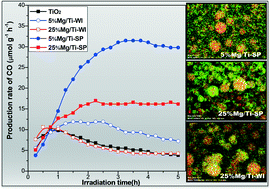CO2 photoreduction with H2O vapor by porous MgO–TiO2 microspheres: effects of surface MgO dispersion and CO2 adsorption–desorption dynamics†
Abstract
Photocatalytic reduction of CO2 with H2O vapor for CO production at a temperature of 150 °C was studied using porous MgO–TiO2 microspheres as the photocatalysts with the benefits of improved CO2 adsorption by incorporating MgO and enhanced products/intermediates desorption at a higher temperature. The MgO–TiO2 microspheres were fabricated by two methods: (1) a one-step spray pyrolysis method using TiO2 (P25) nanoparticles dispersed in Mg(NO3)2 solution as the precursors (Mg/Ti-SP), and (2) spray pyrolysis synthesis of pure TiO2 (P25) microspheres first and then wet-impregnation with MgO (Mg/Ti-WI). The two material synthesis methods led to different MgO dispersion on the TiO2 surface. For Mg/Ti-SP, the strong aggregation of MgO nanoparticles caused a rough surface of the MgO–TiO2 microsphere; while for Mg/Ti-WI, MgO was more uniformly deposited leading to a much smoother surface of the microsphere. The surface dispersion of MgO was found to significantly affect the performance of MgO–TiO2 in CO2 photoreduction. At the same MgO concentration, Mg/Ti-SP had more than two times higher activity than Mg/Ti-WI, and most importantly, little deactivation of the catalyst was observed on Mg/Ti-SP while Mg/Ti-WI started to deactivate after 1 to 2 h when the reactor was operating in a continuous flow mode. The ease of photo-induced electron transfer to the catalyst surface may have contributed to the superb activity of Mg/Ti-SP samples. The optimum MgO concentration was found to be 5% for both types of materials. Besides the dispersion of MgO, we also found that the CO2 adsorption–desorption dynamics strongly influenced the CO2 photoreduction. The results from in situ diffuse reflectance infrared Fourier transform spectroscopy (DRIFTS) revealed two advantages of Mg/Ti-SP over Mg/Ti-WI: (1) more abundant bicarbonates (important intermediates for CO production) on the surface and (2) easier desorption/transformation of intermediates.

- This article is part of the themed collection: Carbon dioxide conversion

 Please wait while we load your content...
Please wait while we load your content...